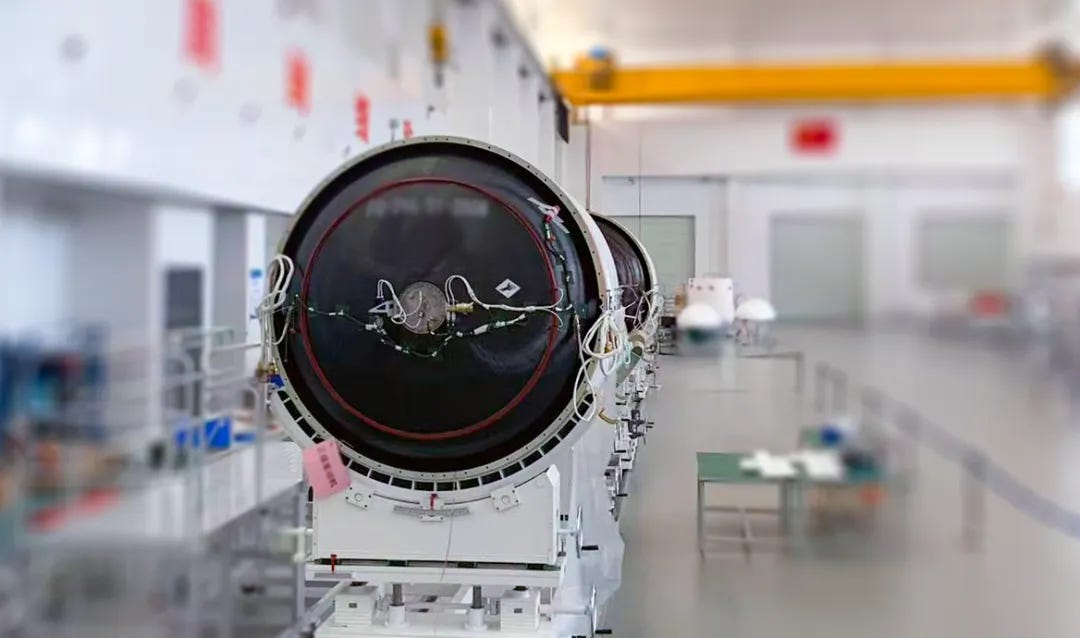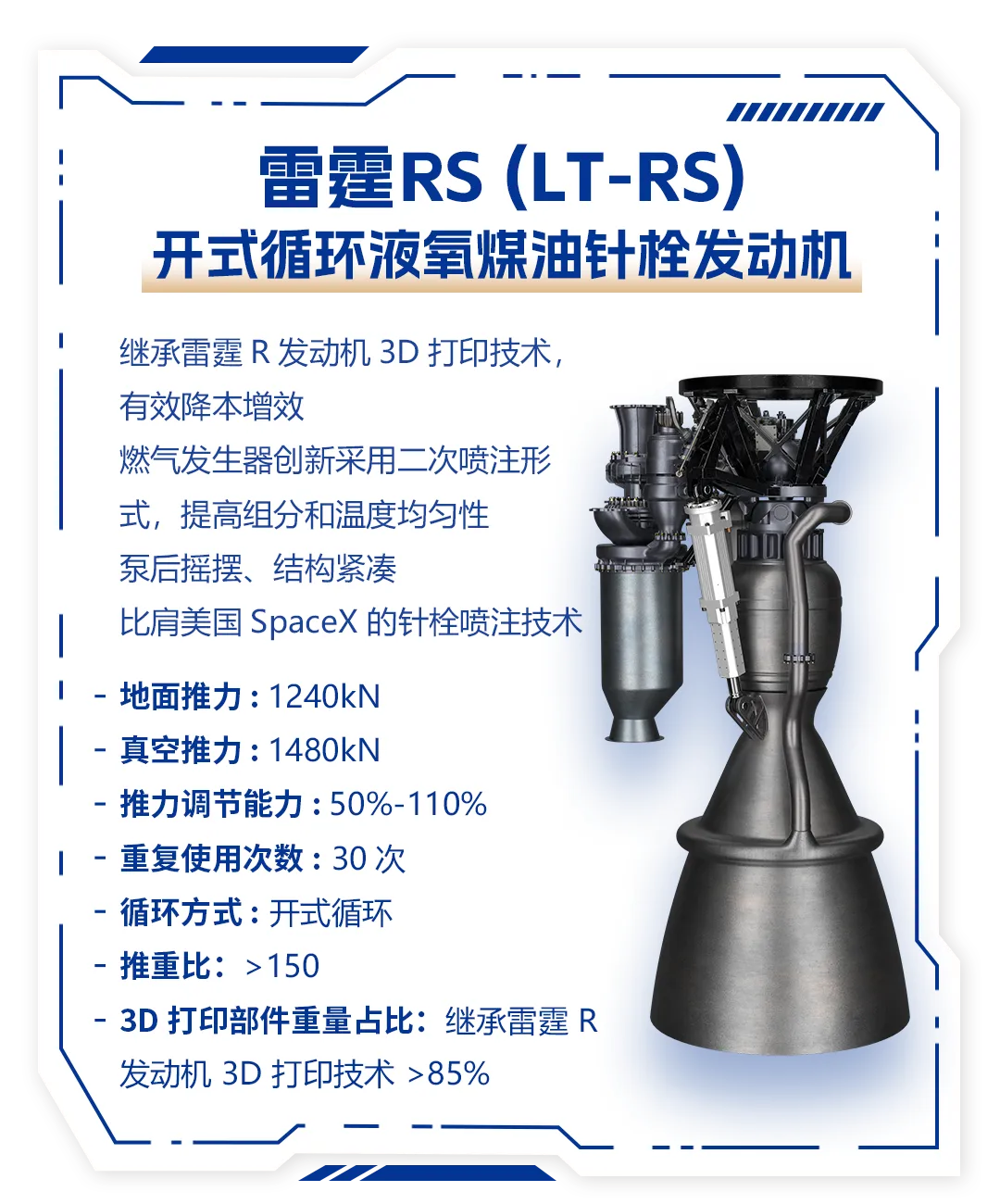Financing, Firings, & Pre-Flight Testing
Development milestones and new investments have occurred in recent weeks.
Three in-development rockets from China’s space sector are moving toward their debut launches, while some new engines have recently fired up, as well as many hundreds of millions being invested into launch and satellites.
Kinetica-2 prepares to launch Qingzhou spaceship
CAS Space announced on September 15th that tests with a low-tech version of the Qingzhou resupply spacecraft, set to fly to the Tiangong Space Station in the coming years, had been successfully performed. Checks performed on the spacecraft and Kinetica-2’s payload adapter included static modal and separation tests, with the company adding the following afterward:
“The ship-rocket separation test verified the correctness and system compatibility of the ship-rocket separation system design, demonstrated significant separation shock response and shock reduction solutions, and validated the feasibility of the Qingzhou cargo spacecraft and rocket body assembly docking process and the coordinated assembly of the separation device, effectively ensuring the safety and reliability of the first spacecraft-rocket joint operation process.”
”Following the successful completion of the ship-rocket separation test, the development team immediately conducted modal tests on the Kinetica-2 ship-rocket combination. These tests accurately determined the ship-rocket modal parameters and fully verified the correctness of the ship-rocket structure and connection configuration, as well as the compatibility of the interfaces. This provided important evidence for revising the dynamic model of the Kinetica-2 Y1 launch vehicle to ensure the success of the flight test.”
”The successful ship-rocket separation and modal tests signal the sprint phase for the Kinetica-2 maiden flight and the launch of the Qingzhou cargo spacecraft prototype. All pre-flight preparations are progressing as planned.”
If there are any problems with this translation please reach out and correct me.
Earlier in the month, CAS Space delayed Kinetica-2’s debut flight from late September to the fourth quarter (October, November, and December).
Galactic Energy prepares to debut Ceres-2, Pallas-1
Galactic Energy shared on September 11th that its partially reusable Pallas-1 and larger solid-fueled Ceres-2 launch vehicles are closing in on their debut flights.
Video in a recent blog post from the company shows that seven CQ-50 engines (capable of generating about 50 tons of thrust each) have been installed into the rocket’s engine section and performed gimbal testing in the factory. So far, thirty of the engines are said to have been produced and tested for flight vehicles, with at least one rocket’s worth of engines installed (including one on the second-stage).
It is currently expected that the first Pallas-1 will arrive at the Jiuquan Satellite Launch Center in November for its debut flight before the end of the year. For its debut flight, the rocket will weigh around 283,000 kilograms, filled with rocket-grade kerosene and liquid oxygen, while carrying up to 8,000 kilograms of payload.
Meanwhile, the company’s larger solid-fueled launch vehicle, Ceres-21, is undergoing final assembly for launch. The roughly 100,000-kilogram rocket is planned to carry eight satellites into orbit during its debut flight.
Deep Blue fires Thunder-RS
On September 16th, Deep Blue Aerospace revealed that they had successfully fired up their rocket-grade kerosene and liquid oxygen burning Thunder-RS2 in a full-system test. The test firing saw the engine generate 130 tons of thrust (through throttling up toward 110 percent power), as well as demonstrating stable startup and shutdown.
In the lead-up to this month’s test, the engine’s gas generator was tested in October 2024, and a partially assembled engine fired up a month later. For the full-system test, a development Thunder-RS engine completed factory inspections in August.
Thunder-RS is currently being developed to power Deep Blue Aerospace’s second launch vehicle, the partially reusable Nebula-2, with its debut flight set for 2026. Twelve engines will be used on the engine, eleven on the first-stage and one on the second-stage, to lift up to 25,000 kilograms to low Earth orbit.
Orienspace completes first Yuanli-110 firing
Orienspace revealed on September 15th that the company has successfully performed a test firing of the Yuanli-110 engine with rocket-grade kerosene and liquid oxygen injected into the combustion chamber for the first time together. This test comes just over ten days after the engine’s gas generator was fired up.
According to the company, this test demonstrated stable operation of the combustion chamber, smooth startup, controllable throttle, and safe shutdown. Further tests of the engine are expected in the near future, likely with a nozzle installed.
Nine Yuanli-110 engines, generating 110 tons of thrust each, are set to power Orienspace’s partially reusable two-stage Gravity-2 rocket’s first-stage, while a single engine will power the second-stage. The rocket may debut sometime in 2026.
iSpace completed D+ series fundraising
iSpace shared on September 19th that they have completed their D+ series funding round, raising 700 million Yuan (about 98.37 million United States Dollars, as of September 21st). Funding in the compani’s latest round was led by Chengdu Major Industrialization Project Phase II Equity Investment Fund Co Ltd (成都市重大产业化项目二期股权投资基金有限公司)3 with Chengdu Airport Innovation and Entrepreneurship Investment Co Ltd (成都空港创新创业投资有限公司) and Chengdu Yingyuan Private Fund Management Co Ltd (成都盈远私募基金管理有限公司).
The new funding is planned to further efforts to have the partially reusable two-stage Hyperbola-34 launch vehicle on the launch pad before the end of the year. Beyond launching the first vehicle, the money will also be used to complete a production facility capable of producing twenty Hyperbola-3’s per year.
The day before the latest fundraising round, Hyperbola-3’s liquid methane plumbing was subjected to cryogenic and vibration testing to verify structural strength and repeated use. iSpace says the hardware successfully passed testing, for another step towards flight later this year.
Geely’s constellation receives 2 billion Yuan investment
Reported by Eastmoney (东方财富) on September 19th, Geespace, the developer and operator of the Geely Future Mobility Constellation, also owned by automaker Geely, has received a 2 billion Yuan (281 million United States Dollars) investment for the construction of a global headquarters for its satellite constellation, as well as expanding services worldwide.
Providing the money for the investment were Zhejiang Financial Holdings Investment Co Ltd (浙江金控投资有限公司), Hangzhou High-tech Financial Investment Holding Group Co Ltd (杭州高新金投控股集团有限公司), and Hangzhou State-owned Capital Investment and Operation Co Ltd (杭州市国有资本投资运营有限公司) through the Zhejiang New Energy Vehicle Industry Fund (浙江新能源汽车产业基金)5.
A four-stage launch vehicle, propelled by three solid-fuel stages and reaching orbit with a liquid-fuelled stage, planned to carry up to 1,600 kilograms into low Earth orbit.
Under Chengdu Advanced Capital (成都先进资本).
Planned to send 13,600 kilograms to low Earth orbit when expended or 8,600 kilograms to low Earth orbit with first-stage reuse.
All three are government-owned, with the Hangzhou companies being controlled by the Hangzhou city government, while the Zhejiang ones are controlled by the provincial government of the same name.





